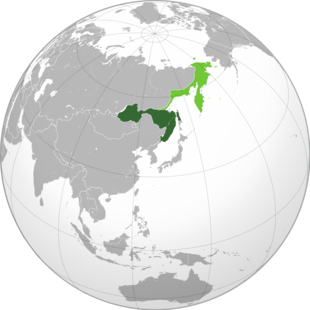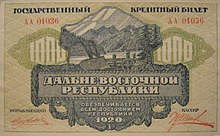Far Eastern Republic
| Дальневосточная Республика | |||||
|
Dalnewostochnaja Respublika |
|||||
| Far Eastern Republic | |||||
| 1920-1922 | |||||
|
|||||
| Capital | Chita | ||||
| Form of government | republic | ||||
| surface | 1,900,000 km² | ||||
| population | 3.5 million | ||||
| founding | 1920 | ||||
| resolution | 1922 | ||||
| Far Eastern Republic 1920–1922 (the northern areas ceded to the RSFSR at the end of 1920 are shown in light green) | |||||
The Democratic Far Eastern Republic , just mostly only Far Eastern Republic ( FÖR ; Russian Дальневосточная Республика, ДВР Dalnewostotschnaja Respublika DWR ), was an existing between April 6 1920 and the November 15, 1922 Socialist Soviet Republic in the Russian Far East and in South and Eastern Siberia .
Territory development



The Far Eastern Republic stretched from Lake Baikal (Baikal area and Transbaikalia) along the Mongolian and Chinese borders (coastal and Amur province opposite Manchuria ) and along the Sea of Okhotsk and the Pacific up to Kamchatka and the Chukchi Peninsula , but did not include Yakutia .
The western part of the settlement area of the Mongolian Buryats came to Soviet Russia , the eastern part to the Far Eastern Republic.
At the end of 1920, Kamchatka and the Chukchi Peninsula were ceded to the Russian Soviet Federal Socialist Republic .
North Sakhalin was occupied by the Japanese during the entire existence of the FÖR.
history
background
In the Russian Civil War , which followed the October Revolution and the Bolshevik seizure of power, the Japanese Empire - as part of an intervention by the Western powers - supported the troops of the White Army in their fight against the Red Army .
Between April 1918 and 1922, more than 70,000 soldiers of the Imperial Japanese Army occupied Vladivostok and parts of the Russian Pacific coast in the Siberian Intervention . In February and March 1920, the Nikolayevsk incident occurred , which culminated in a massacre of several hundred Japanese in the city of Nikolayevsk on the Amur .
In support of the Czechoslovak Legions , which also fought on the side of the White Army and controlled large stretches of the Trans-Siberian Railway , the USA also sent a contingent of almost 8,000 soldiers between 1918 and 1920 with the American Expeditionary Force Siberia .
Established as a Soviet buffer state
In order to prevent a direct war between Soviet Russia and Japan after the Nikolayevsk incident , Soviet Russia founded the Far Eastern Republic on April 6, 1920 as a " buffer state " .
After the expulsion of the White Guard general Grigory Semenov in October 1920, not Vladivostok but Chita became the capital of the Far Eastern Republic under the Soviets .
From 1920 to October 1922, Japan tried, with the help of White Guards and renegade communists, to split off the Primorye region : In May 1921, the coastal republic came into being under Japanese control .
At the Washington Naval Conference on February 6, 1922, representatives of the Far Eastern Republic instead of Soviet Russia sought diplomatic recognition by the United States and US pressure on Japan to clear the territories of the coastal republic.
In July 1921, Wassili Blücher , who had fought against the Czechoslovak legions in Siberia as early as 1918/19 , became Minister of Defense of the Far Eastern Republic. After the last Japanese troops withdrew from the coastal republic in September 1922, Vladivostok, held by the White Guards, was captured on October 25, 1922. The last fights were immortalized in the song “ Partisans from the Amur ”.
Negotiations with Japan
Despite or parallel to the military confrontation, negotiations also took place between the Far Eastern Republic and Japan.
First round: August to October 1921
The Japanese ambassador in Beijing had surprisingly proposed to the representative of the Far Eastern Republic in China that normal diplomatic relations should be established. On August 21, 1921, the first round of negotiations began in the Japanese lease area Dairen . The Japanese did not want to negotiate a troop withdrawal until later and, above all, without the participation of Soviet Russia. Negotiations about a withdrawal should only take place after the Nikolaevsk incident was settled. While the Far Eastern Republic of Japan offered concessions and most-favored-nation treatment, Japan asked North Sakhalin as compensation.
In October 1921, Japan summarized 17 demands in one draft. The most important of these Japanese demands were the razing of all fortifications, the FÖR's renouncement of a fleet, the contractual assurance of the prevention of a communist regime, numerous special economic rights (which went beyond the concessions offered and most-favored-nation treatment) and the leasing of northern Sakhalin Japan for 80 years. Since the FÖR rejected these demands, Japan broke off the negotiations.
Second round: March to April 1922
In a second round of negotiations at the end of March 1922, the FÖR Japan offered further-reaching economic benefits and special rights, but no agreement could be reached on a deadline for the Japanese withdrawal. Instead, on April 15, Japan made new demands similar to the 17 demands that had already been rejected. As a result, the talks were broken off again on April 16, 1922.
Third round: September 1922
On September 4, 1922, representatives of Japan and the FÖR met again at the Japanese consulate in Changchun (Manchuria), the subject of the negotiations should be a trade agreement. Japan again promised a troop withdrawal, but again demanded that the Nikolaevsk incident must be settled first. When the FÖR initially only proposed an investigation into the incident, Japan broke off negotiations on September 26th.
With the victorious advance of the Red Army, the Soviets finally saw no need for a negotiated solution either. In September 1922, the Japanese army finally withdrew.
Connection to the Soviet Union
On November 15, 1922, the Far Eastern Republic proclaimed its annexation to the Soviet Union . North Sakhalin remained under Japanese control until 1925.
Head of state
- Alexander Krasnoschtschokow (April 6, 1920 - December 1921)
- Nikolai Matveev (December 1921 to November 15, 1922)
Belletristic reception
The Russian writer Boris Pasternak mentions the Far Eastern Republic in his 1957 novel Doctor Zhivago .
literature
- The Far Eastern Republic (1920–1922): A State Attempt at the Time of the Russian Civil War. In: Harald Heppner , Eduard Staudinger (ed.): Region and upheaval 1918 - On the history of alternative attempts at order. Lang, Frankfurt am Main 2001, ISBN 3-631-37349-X , pp. 231-260.
- David Golinkow: Fiasco of a counter-revolution. The failure of anti-Soviet conspiracies in the USSR. 1917-1925. Dietz, Berlin 1982.
-
Vladimir P. Potjomkin (ed.): History of diplomacy . 2nd Edition.
- Second volume: The Diplomacy of Modern Times, 1872–1919. SWA-Verlag , Berlin et al. 1948.
- Third volume, part 1: Diplomacy in the preparation period for World War II, 1919–1939 . SWA-Verlag, Berlin et al. 1948, (The collective of authors led by Potjomkin also included Jewgeni Tarle and Isaak Minz ).
Web links
- History of the Far Eastern Republic (Russian)
- Дипломатический словарь: ДАЙРЕНСКАЯ КОНФЕРЕНЦИЯ 1921-22
Individual evidence
- ↑ a b c Björn Berge: Atlas of the Disappeared Lands , pp. 146–149. dtv, Munich 2018
- ↑ a b Administrative division of the FÖR ( Memento from July 19, 2011 in the Internet Archive ) (Russian)
- ↑ a b Potjomkin, Volume 3, Pages 160f
- ↑ Potjomkin, Volume 3, pp. 179f
- ↑ Potjomkin, Volume 3, pages 243ff
- ↑ Dorothy Perkins: Japan Goes to War: A Chronology of Japanese Military Expansion from the Meiji Era to the Attack on Pearl Harbor (1868-1941) , DIANE Publishing, 1997, ISBN 0-7881-3427-2 , p. 97.
- ↑ Emma Goldmann: Lived Life. P. 735.



